#Clarendon Palace
Text
A VISIT TO KING'S LANGLEY
King’s Langley was once home to a massive Plantagenet palace, built out of the remnants of a hunting lodge of Henry III for Edward I’s Queen, Eleanor of Castile. She furnished it lavishly, with carpets and baths. There were shields decorating the hall and a painted picture of four knights going to a tournament, while the expansive gardens were planted with vines. After her death, the palace was…
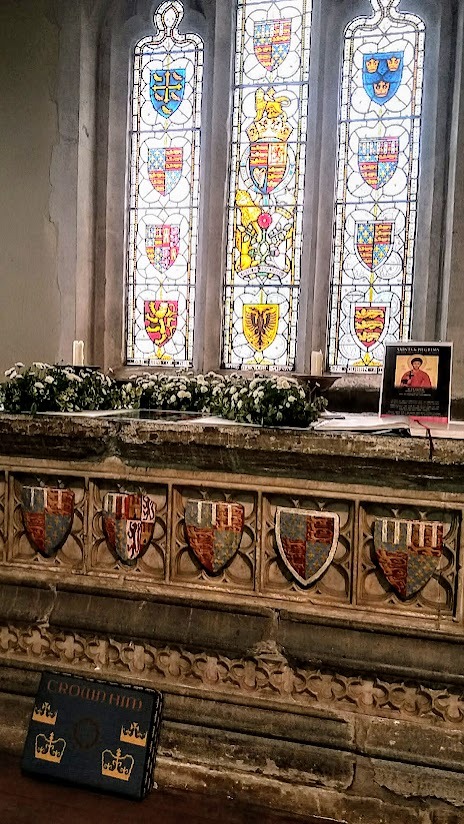
View On WordPress
#Anne Mortimer#camels#Cecily Neville#Christmas#Clarendon Palace#clocks#Dominican friaries#Edmund of Langley#Edward II#Edward III#Eleanor of Castile#fire#Henry III#Henry IV#Isabel of Castile#Joan of Navarre#John of Wheathampstead#King&039;s Langley#palaces#Piers Gaveston#Reformation#Richard Earl of Cambridge#Richard II#royal tombs
10 notes
·
View notes
Photo
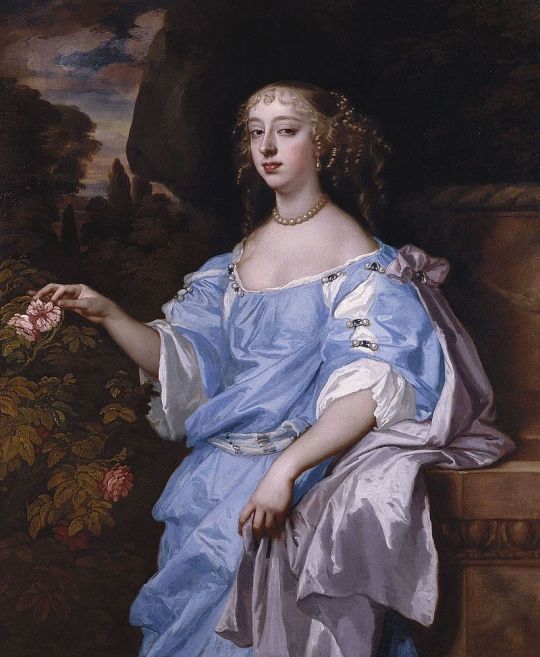
Henrietta Hyde, Countess of Rochester (née Boyle; 1646 – 12 April 1687) was an Anglo-Irish noblewoman. She was one of the Windsor Beauties painted by Sir Peter Lely.
She was born in Wiltshire, England to Sir Richard Boyle, 2nd Earl of Cork and Elizabeth Boyle, Countess of Cork. In 1665, she married Laurence Hyde, 1st Earl of Rochester, son of Edward Hyde, 1st Earl of Clarendon and Frances Aylesbury. Henrietta had four children.
Like most of the Boyle dynasty, who in the space of two generations had become almost all-powerful in the south of Ireland, Henrietta was strong-minded and acquisitive, and could be ruthless in asserting her rights. During the last two years of her life, when her husband was Chief Minister to his brother-in-law King James II, Henrietta took full advantage of his power to claim every possible privilege. She clashed bitterly with her husband's niece, the future Queen Anne, over who should have the best apartments in Whitehall Palace. Anne, who could herself be a formidable opponent, complained bitterly of her aunt's "peevishness" to her.
14 notes
·
View notes
Text
Parcial III: informe
Blemheim Palace

El Blenheim Palace es una enorme casa de campo que se encuentra en Woodstock, Oxfordshire, y es la residencia de los duques de Marlborough. Se trata de la única casa de campo no real y no episcopal que se encuentra en Inglaterra y tiene el título de palacio. , fue construida entre los años 1705 y 1722.
Los arquitectos seleccionados para la construcción del palacio fueron Jhon Vanbrugh, un arquitecto, que tuvo otras disciplinas, es un gran representante de la arquitectura barroca, además de haber creado el Palacio Blenheim, se le conoce también por la creación del Palacio Howard, un palacio increíble, el cual fue el debut del Vanbrugh, quien eligió el estilo barroco continental para desarrollarlo.
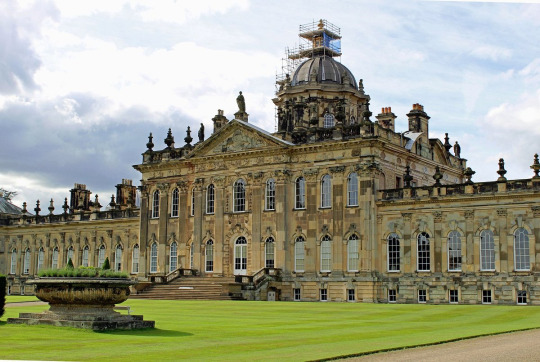
El segundo arquitecto del Blenheim fue Nicholas Hawksmoor, quien terminó la construcción debido al abandono de Vanbrugh, por las disputas con la duquesa. Este arquitecto diseñó el edificio Clarendon de Oxford y la Abadía de Westminster.
El Palacio Blenheim es una referencia de poder y riqueza, cuenta con un Arco del triunfo basado en el “Arco de Titus” en la vía Sacra, ubicado en la entrada del edificio, es un palacio que se desarrolla de forma longitudinal. Cuenta con habitaciones de recepción, habitaciones privadas del duque y la duquesa Churchill. Blenheim es la única residencia no real ni episcopal de la campiña inglesa que recibe el título de palacio.
A los laterales del patio sur se encuentran dos grandes espacios siendo el del este donde se encuentran los cuartos de servicio y cocina, y en el oeste se encuentran la capilla y los establos.
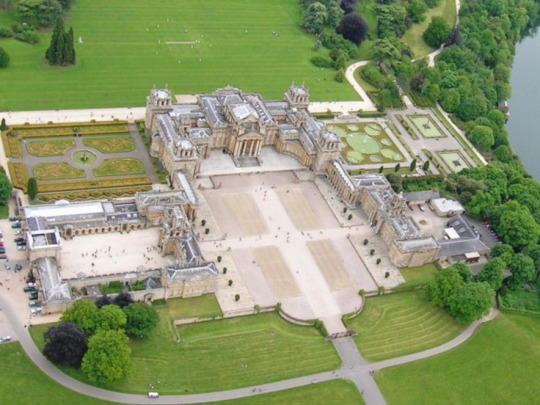
En las esquinas del palacio se encuentran grandes torres que imitan a un pilón egipcio, de material macizo, para darle aires de fortaleza y dureza a la edificación.
Al oeste a lo largo del Piano Nobile, se encuentra una gran galería que se ocupaba antes para el arte, y que actualmente se usa como librería.
Una de las habitaciones que más me llamó la atención es La Sala Larga, se llama así porque mide 55 metros de longitud, y convirtiéndose así en la habitación más larga de toda Inglaterra.
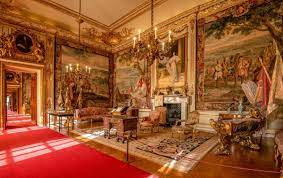
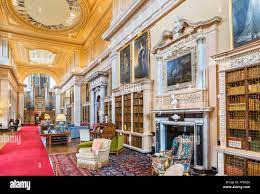
Fue una habitación multifacética que tuvo distintos usos a lo largo de los años, sus dimensiones hicieron de ella un especie de hospital militar durante la Primera Guerra Mundial y años después, tras el estallido de la Segunda Guerra Mundial, fue el dormitorio de los estudiantes que habían sido evacuados del Malvern College.
Actualmente puede contener alrededor de 10,000 libros, la mayor parte de la colección fue del Noveno Duque. Dentro del muro, en el extremo norte, cuelga una estatua de la reina Ana, el rey Guillermo III y el primer duque, John Churchill. Los techos de estuco ordinarios diseñados, incluidos dos cúpulas falsas, se completaron en 1725.
Otros de los puntos maravillosos de este palacio son los jardines, es un palacio rodeado de naturaleza típica del barroco, gran parte del jardín fue organizado a la italiana, con un cruce regular de caminos flanqueados por hileras de arbustos. El cardenal Francesco Baberini mostró un gran interés por la organización del jardín, por lo que siguió los consejos de Cassiano dal Pozzo, un apasionado de la botánica.
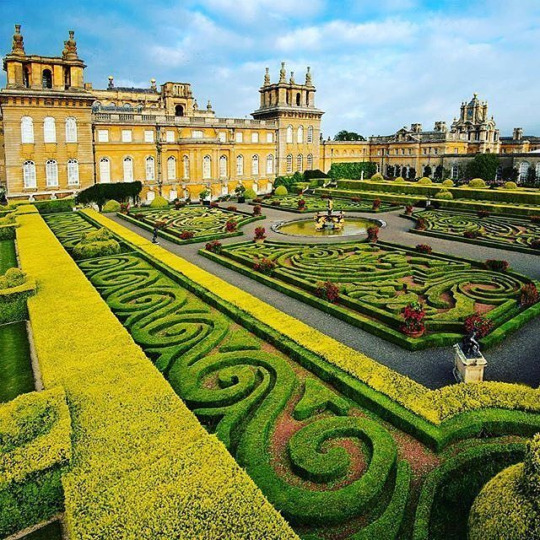
El jardín está a nivel superior respecto al patio de entrada, también está unido a otra sala elíptica de la primera planta mediante un puente. El palacio tiene dos alas, una que da paso al jardín y otra al paisaje citadino. Estos jardines principalmente junto al palacio y comprenden el jardín italiano, Secret Garden, Jardín de las Rosas, el Churchill Memorial Garden, y las terrazas de agua.
La parte más impresionante de estos jardines es, en definitiva, al aire libre, es definitivamente el Laberinto de Marlborough, el segundo laberinto simbólico más grande del mundo. El laberinto tiene tres kilómetros de longitud y está formado por cientos de tejos con un diseño inspirado en la historia del Palacio de Blenheim.

Para concluir, podemos evidenciar que el palacio Blenheim es un palacio 100% barroco, podemos catalogarlo como barroco inglés por su equilibrio entre lo ostentoso y la simpleza que los rodea, esos espectaculares jardines hacen de la obra una belleza que compagina a la perfección con el resto de sus elementos, la obra cuenta con esa contradicción barroca entre el adentro y el afuera de la edificación, está rodeada de drama a través de su historia, y lo más interesante es que tiene algunas referencias clásicas que, en conjunto con todo lo anterior nombrado hacen una edificación preciosa.
0 notes
Photo
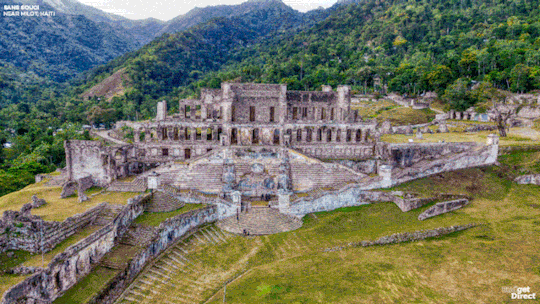
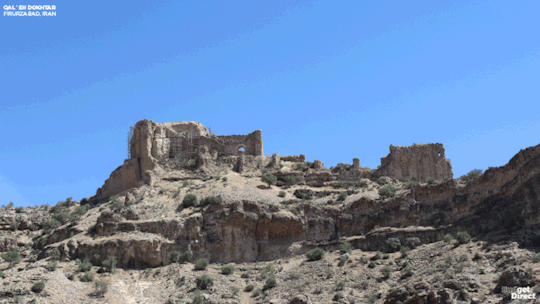

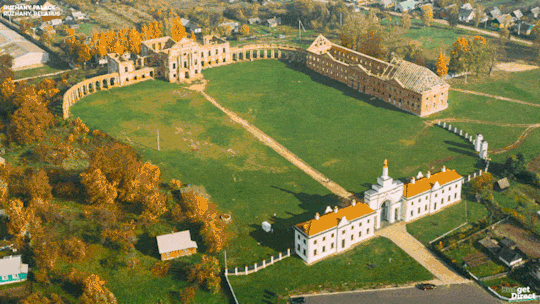
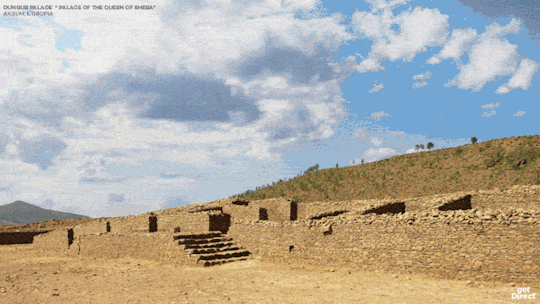

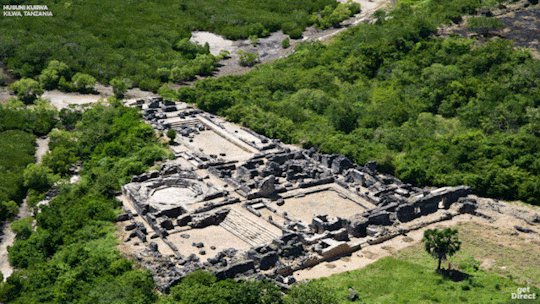
7 Ruined Palaces Around the World, Reconstructed!
Sans Souci, Haiti,
Called the ‘Versailles of the Caribbean’, the palace’s majestic steps and terraces are an impressive monument to Haitian independence.
Qal’eh Dokhtar, Iran,
Qal’eh Dokhar was built by Ardašīr I as a “barrier fortress” during his 3rd century founding of the Sasanian Empire in Iran. The fortress’s third floor housed his royal residence but was eventually supplanted by a greater palace he built nearby. Qal’eh Dokhtar boasts perhaps the earliest example of an Iranian chartaq—a square of four arches supporting a dome—which became an important feature of traditional Iranian architecture.
Knossos Palace, Greece,
The oldest palace on this list by two millennia, Knossos, was constructed circa 1700 BC. In addition to its political function, it also was designed as an economic and religious centre for the mysterious Minoan civilization. Knossos was destroyed circa 1375 BC—surviving invasion, fire, and earthquake nearly a century longer than similar Minoan complexes.
Ruzhany Palace, Belarus,
The Sapieha family—power-brokers of the Polish-Lithuanian Commonwealth—built Ruzhany Palace in the late 1700s over the site of their earlier castle. In its heyday, Ruzhany’s famed theatre employed 100 performers. The palace also possessed a famous library and picture collection.
Dungur Palace / “Palace of the Queen of Sheba,” Ethiopia,
Dungur Palace is in the Ethiopian village of Aksum—once the bustling capital of an African empire that stretched from southern Egypt to Yemen. The 6th-century mansion contains approximately 50 rooms, including a bathing area, kitchen, and (possible) throne room.
Clarendon Palace, UK,
Despite the composition of a very significant English legal document within its halls, this 12th-century palace is nearly forgotten. The ‘Constitutions of Clarendon’ were Henry II’s attempt to gain legal authority over church clerks, but he instead exacerbated a feud with his friend Thomas à Becket. This feud eventually led to Archbishop Beckett’s martyrdom. Henry III expanded the palace, commissioning a carved fireplace and stained glass chapel. By the 1400s, Clarendon was a sprawling royal complex. It remained a favourite retreat of monarchs until the Tudor era, when the high cost of upkeep resulted in its rapid decline. Today, only a single wall remains above ground.
Husuni Kubwa, Tanzania,
The island of Kilwa Kisiwani was one of the most important sultanates in the “Swahili Coast’ trade network, linking East Africa to the Arabic world. For over 300 years, gold and ivory passed out of its ports, while Chinese silk and porcelain flowed in. The 14th-century palace at Husuni Kubwa is just one of many coral stone ruins that dot the island.
Husuni Kubwa was built by Sultan al-Hasan ibn Sulaiman. It had over 100 rooms, an octagonal swimming pool, and a staging area for loading goods onto ships. Husuni Kubwa, along with other elite Kilwa dwellings, was also equipped with indoor plumbing.
Created by: Budget Direct in collaboration with: Neomam Studios
#art#design#architecture#palace#palacegif#animated gif#tanzania#husuni kubwa#budgetdirect#neomanstudio#ruined#san souci#haiti#clarendon palace#united kingdom#luxurylifestyle#style#history#belarus#knossospalace#greece#dungur palace#ethiopia#ruzhani palace#iran#qal'eh dokhar#royal#royalpalace
485 notes
·
View notes
Text
The Kingdom of Allycia
Founded in 1691 upon its defeat of Torenthian troops at the Battle of Angria, the Kingdom of Allycia is a peaceful, agrarian nation that makes up most of Central Oceana. It has been ruled by the Wyndham family for more than 300 years.
Prior to the elevation of King Allain Wyndlin (the family changed its name to Wyndham in 1794) to the throne, the region had been a province of the Torenthian Empire for nearly a century. Yet, as Torenth continued to demand more resources from Allycia, its people began chafing under the yolk of what they still considered to be “foreign rule.”

The Imperial Governor of Allycia, George Insbruck, ignored the signs of rebellion in the air and endulged his legendary appetite for power and prestige, snubbing some of the area’s oldest noble families for Torenthian expatriots, many of whom had settled in the region. This was the final straw for Allycia’s people. In 1690, an uprising in the city of Athenor (later Althorpe) began what would come to be known as “the cleansing,” in which Insbruck was captured and executed, and dozens of Torenthian nobles and businessmen either murdered by roaming gangs or expelled from Allycia for their own protection.
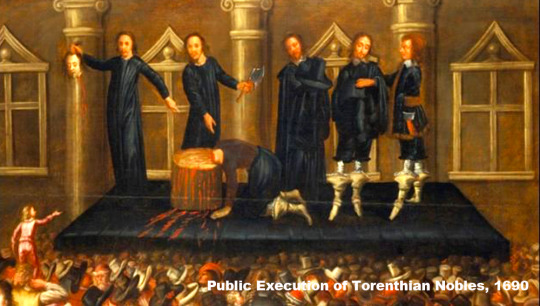
To quell what it considered a minor rebellion, the Torenthian emperor, Joseph I, sent a small army south with the expectation of a quick victory. Hopes for that victory faded quickly as the army’s general, Samuel Holbruck, 3rd Duke of Brenholdt, realized the scale of the revolt was much greater than originally reported.
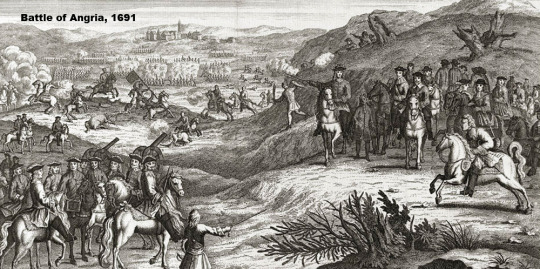
Meeting Allycian troops in the foothills near Angria, the Torenthian army was defeated and driven north by Allain Wyndlin, a passionate local noble from Athenor who had emerged as a leader of the rebellion.
Upon this defeat, Wyndlin was hailed as king on the field, and marched back to Athenor, where he was later crowned as Allain I.

The king led troops against several Allycian cities who bridled under the thought of trading an emperor for a king, yet was ultimately successful in consolidating his power and bringing peace to the region. Declaring Althorpe as the capital, he began the process of building Allycia into a regional power and enhanced its defenses in case of yet another attempt by Torenth to regain control of the country.
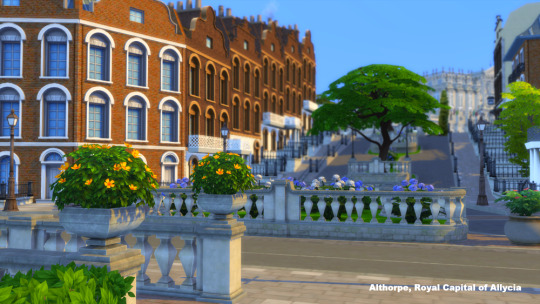
Today, Althorpe remains Allycia’s largest city, although New Trier to the east is a thriving cultural center. To the West, along the coast, the Bay of Brighton is home to Clarendon, the kingdom’s commercial and trade center.

While smaller in land area by far than the Torenthian Empire to the north, Allycia is also the breadbasket of Oceana, producing more food per capita than any other region on the continent. As such, it actively trades food and other natural resources with its neighbors both north and south. Despite their violent history, Allycia and Torenth were able to build a strong relationship that continues to bring a sense of stability to the region.
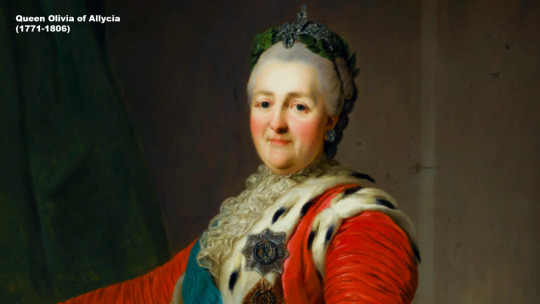
While the Kings and Queens of Allycia wielded absolute power for generations, progress and a greater awareness of world events brought swift change in 1794, when Queen Olivia Wyndham signed into law a new constitution, granting the people voting rights and establishing a National Council to represent the people’s interests. This shared body, representing both the nation’s aristocratic and common populations, preserved Allycia’s monarchy into the modern era.

The royal family, ruling from its home at Althorpe Palace, was fortunate to retain some political powers, allowing them greater impact on domestic affairs than many of their fellow monarchs.
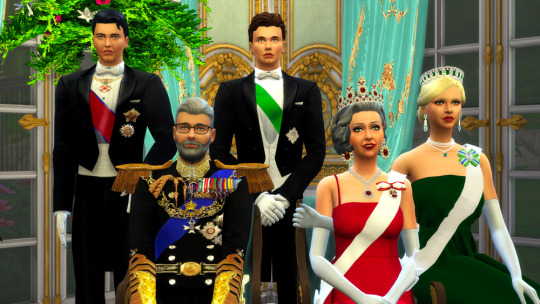
Allycian Royal Family (l-r): Crown Prince Richard (now King Richard II), the late King Nicholas II, Prince Thomas, the late Queen Margaret and Princess Allisthene (known as Allison), who is now the Empress of Torenth.
Today, the Wyndham family continues to rule benevolently in Allycia. Although a majority of the nation’s legislative powers lie in the hands of the Allycian National Council, the royal family continues to be the heart and soul of Allycia’s national identity, giving them a great deal of political clout they remain careful not to waste needlessly.
READ STORY FROM BEGINNING
Continent of Oceana | History of Weston | History of Corwyn | History of Torenth
#TS4#ts4 story#ts4 royal family#ts4 royalty#ts4 royal legacy#ts4 royal story#ts4 royal simblr#ts4 simblr#Kingdom of Allycia#Kingdoms of Oceana#Oceana Stories
8 notes
·
View notes
Text
EDWARD THE BLACK PRINCE OF WALES
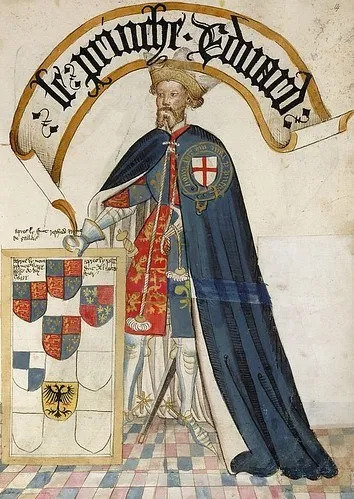
Also known as ‘Edward of Woodstock’, Edward the Black Prince was the eldest son of King III of England and Philippa of Hainault. Although he never became the king, he was the heir apparent to the English throne. His limited years did not limit his power and he made a name for himself through his military brilliance and achievements. Of all the battles he fought, his victories against the French in the Battle of Crécy and the Battle of Poitiers are notorious.
There is no clear evidence as to why he became to be known as Edward The Black Prince Of Wales but some historians suggest that it was referred to his black shield and body armour while others argued that it referred to his cruelty to the French people. Moreover, he was given this name after about one hundred and fifty years after his death. In his life, he was only known as ‘Edward of Woodstock’.
Early Life
Born on the 15th of June 1330 at Woodstock Palace in Oxfordshire, Edward of Woodstock was the eldest son of King Edward III of England and was the heir to the English throne. Since he died a year before his father at the age of 45, his son Richard II succeeded the throne. Edward was given the following titles:
Earl of Chester
Duke of Cornwell
Prince of Wales
Prince of Aquitaine
Knight of the Garter
Marriage
The negotiations for Edward began when he was only 7 years old. He was married to his father’s cousin who was the divorced and widowed countess of Kent in October 1361 at Windsor castle. They had two sons, Edward and Richard. The eldest son Edward died of plague at the mere age of six, whereas the younger son Richard grew up to inherit the throne after his Grandfather and become to be known as King Richard II.
He also became the step-father to his wife Joan’s children from her previous marriage which included Thomas and John Holland. Apart from his two legitimate sons, he also had several illegitimate children which were not considered unusual at that time. His illegitimate children included Sir Roger Clarendon whom he had with Edith de Willesford and three other sons called Edward, Sir Charles FitzEdward, and Sir John Sounder.
Titles and achievements
He received his first suit of armour at the age of seven. Soon afterward he was granted revenue from the newly created Duchy of Cornwell by his father King Edward. However, if the future monarch did not have a son then the revenue from the Duchy would be reverted to the crown. Hence, eventually, Prince Edward was made theDuke of Cornwell.
At the age of 13, Edward was made the Prince of Wales and he proved his position 3 years later at the Battle of Crécy in North-Eastern France in August 1346. The English had a total victory over the French. During the Hundred Years’ War, Edward often fought with the French. Another major achievement for him came from the Battle of Poitiers when he defeated the French and even captured the French King as a prisoner.
After his achievements in the Hundred Years’ War against the French, Edward’s reputation got stained in September 1370 due to the French town of Limoges. A friend of Edward and the godfather to his son, Johan De dross who was also the Bishop of Limoges betrayed Edward and defected to the french by welcoming a garrison into a part of the town.
A massacre followed upon Edward hearing the news where he put 3,000 men, women, and children to death. Despite them pleading for mercy, Edward listened to none and almost destroyed the entire population of Limoges. This cruelty shown by him is also suggested to be one of the reasons he is termed as the Black Prince of Wales.
After his military success in France, he turned towards Spain where he helped the deposed King Pedro the Cruel of Castile defeat his illegitimate brother known as the henry of Trastamara. He was defeated at Najera in Castile and hence Edward was awarded the Black Prince’s Ruby by the Spanish King. Moreover, Edward was also among the 25 founding knights of the Order of the Garter.
Hundred Years’ War
In 1337 CE, King Edward decided to expand his lands in France. Moreover, the King’s mother Isabella being from France (the daughter of Philip IV of France) gave him an excuse to have a right to claim the French throne. However, the king of France at the time, Philip VI refused to step down from his throne. Hence, the Hundred Years’ War between France and England began in which Prince Edward played a major role starting from the Battle of Crécy in 1346.
Battle Of Crécy
Edward was known to use the strategy chevauchée which was a common part of medieval warfare and is known to be used as far as back in 1066 CE by William the Conqueror. The strategy aimed to perform multiple functions such as instilling fear and terror in the locals, provide free food for an invading army, get booty and ransom for noble prisoners, and to ensure that the opposite army had a weak economic base.
Moreover, ordinary troops also caused mayhem and executed raids on the opponent’s army whenever they could get a chance. The potential outcome of this strategy was brutal economic warfare and provoking the enemy to attack. This is exactly what happened with the King of France and hence on the 26th of August, the two armies met when King Phillip of France decided to invade England’s army.

Prince Edward who was only 16 at the time led the English army with his right-wing and Sir Godfrey Harcourt. Although the prince fought with great bravery there came a point when the French seemed to be winning. Sir Godfrey called for reinforcements however the King upon hearing the news stated that if his son could extricate himself from the battle then he would win his spurs which was a sign of knighthood and were awarded in a full knighting ceremony.
Eventually, Edward the Black Prince’s army overcame their numerical disadvantage by taking a defensive position on the River Maie. The French army retracted after getting into a muddle. King Edward won the battle with only 300 casualties whereas the French had a great number of casualties of around 14,000. Not only that but the battle also resulted in their fallen reputation. The King John of Bohemia, the Count of Blois, and the Count of Flanders were also eliminated in the Battle of Crécy. Afterward, Prince Edward adopted the emblem and motto of the fallen king of Bohemia.
After the success at the battle of Crécy, England’s success continued when Edward the Black Prince backed an army of around 26,000 men and captured Calais after a year-long siege in July 1347 CE. The Black Prince’s reputation further grew when after three years, in January 1350 CE, along with his selected unit of knights, he protected the city against a French plot that Involved Italian mercenaries.
Chivalry and Garters
To celebrate the Prince’s medieval tournaments, he and his father participated in the great 15-day tournament in 1344 CE at Windsor Castle. The prince’s father, Edward III found the exclusive Knights club and epitome of medieval Chivalry of which the prince was also the founding member and was given the Order of the Garter in 1348 CE.
This order is known to be one of England’s most oldest and prestigious and included only 24 chosen knights, the King, and the Black Prince. The chosen knights had all fought in the battle of Crécy. The symbol of the order was a garter and its motto read, “evil on him who thinks it” referring to anyone who had doubted the king’s right to rule France. Moreover, The garter on the order had the royal colours of France; blue and gold.
Battle of Poitiers
The new King of France, John II was not any different from the previous one. He continued to war with England. Hence, in 1355 CE Gascony was raided and Bordeaux was captured by Edward the Black Prince which he used as his base. The Prince used the same strategy he used in the Battle of Crécy and torched cities and farmlands.
Again just as the previous king, this strategy also provoked the new French King to take the same steps, and hence, the French surprised the English army on the 18th of September 1356 CE. A mighty battle started the next day 4 miles from Poitiers. Once again the French army outnumbered the English army (35,000 vs 7,000). However, they could not handle the power and accuracy of the English longbow. Eventually, England won and the King John of France himself was captured along with 2,000 other French knights.
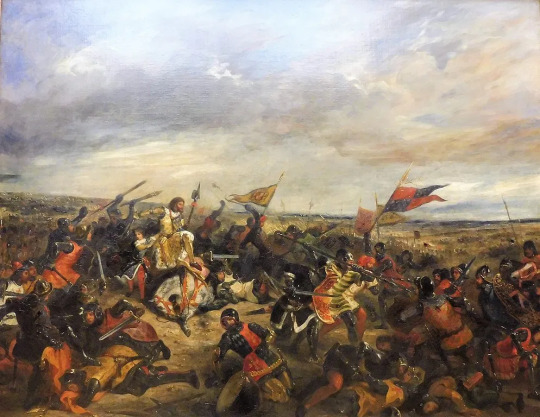
Edward gained further reputation because of the chivalrous behavior he showed to the King of France after capturing him as a prisoner and while escorting him back to England. Moreover, he also distributed gold and titles to his commanders and donated huge sums to churches such as the Canterbury Cathedral.
Although King Edward marched to Rheims and made himself the King of France, the harsh winters there reduced his army. Hence, he signed a peace treaty in 1360 CE between England and France which is called the Treaty of Bretigny. In 1362 CE, King Edward III, who was the Lord of Aquitaine, made his son, the Black Prince, the Prince of Aquitaine.
Castile and Najera
After the treaty of peace, the Black Prince turned to Castile in Spain. The fallen king of Spain Pedro wanted to reclaim the throne from his half-brother HenryII of Castile who had the support of the French. On 3rd April 1367 CE, Prince Edward won the Battle of Najera against the French at the Najerilla river. He even managed to sell one of the prisoners for a massive ransom.
Hence, he was titled the greatest knight ever, Bertrand du Guesclin, the ‘Eagle of Brittany’. He also received a memento from Pedro that became to be known as Black Prince’s Ruby. Although the Battle of Najera was a great military feat, it also proved to be a financial disaster for the Black Prince.
Death
Due to his ill health, the Prince returned to England in 1371. He resigned from his principality next year and started taking a more active part in England’s internal politics where he was known for the constitutional policy of the commons against the corrupt court and the party of Lancastrians.
Edward the Balck Prince of Wales died at the age of 46 on 8th June 1376 CE. The exact cause of his death is unknown but it is said that he suffered from many illnesses from dysentery to old war wounds and even cancer. Although the cause of his death might never be known, it is known that he died before ascending the throne.
A year after his death, his father, King Edward III also passed away and Edward the black prince’s son Richard inherited the throne. Moreover, due to his death, his work in the parliament remained undone and the year following his death, the parliament itself was resolved.
He is buried in Canterbury Cathedral where his black helmet, shield, and gauntlets are hung above. The space beside him was kept for his wife. However, she was buried next to her first husband. According to some theories, the prince chose Canterbury Cathedral as his burial place as his confession of his sins. This was because the Canterbury Cathedral was considered a place of penance and repentance. Moreover, The black prince also ordered the following French poem to be Inscribed around his tomb at Canterbury:
Such as you are, Sometimes was I.
Such as I am, So you shall be.
I thought little of Death
So long as I enjoyed life.
On earth, I had great riches…
Land, houses, great treasure, horses, money, gold…
But now I am a poor captive,
Deep in the ground, I lie…
My great beauty is all gone,
My flesh is wasted to the bone…
5 notes
·
View notes
Text
King Pedro V 1st Trip (May 28th to September 15th, 1854): England, Part 2

In the days that followed, the agenda would not be lighter. At 4, he heard mass, in the French chapel where he met "the famous Saraiva." At the Portuguese embassy, in Gloucester Place, he met several Portuguese people. During lunch, Lavradio drank to his health. In the afternoon, they went to the Zoo:
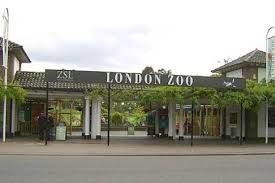
“I gave Lord Fabley my arm, brother Luis to Colonel Wylde and the others walked behind.” He didn't like some of the things he observed: “I started by seeing the bears and some carnivores that I expected to be better treated and even represented by more beautiful specimens.” But he liked the white hyena, the fish and the collection of birds of prey. That day, he also wrote: “I forgot to mention the Myrmecophagas jubatas,

which are certainly the most notable quadrupeds in the entire collection.” At the end he noticed that the rhino was tame, that the giraffes seemed acclimated and that the hippo was in a bad mood. The day went on, at least, until the conversation, at night, with Lord Clarendon,

"about Spain and Portugal."
It is not possible to record, in the same detail, the way D. Pedro spent the other days. During his stay in England, the longest of all, he visited monuments, strolled in the gardens of Windsor,
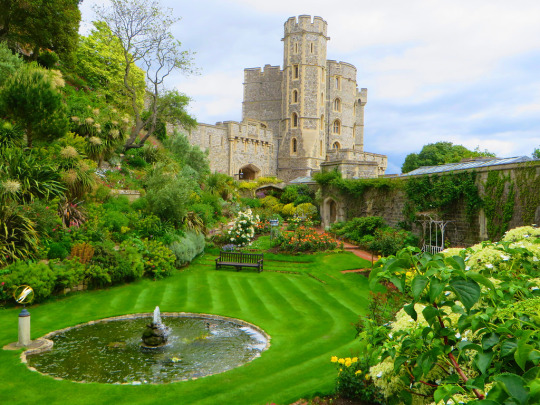
went to the opera, received the diplomatic corps, rode horses in Hyde Park,

admired pieces from the British Museum,
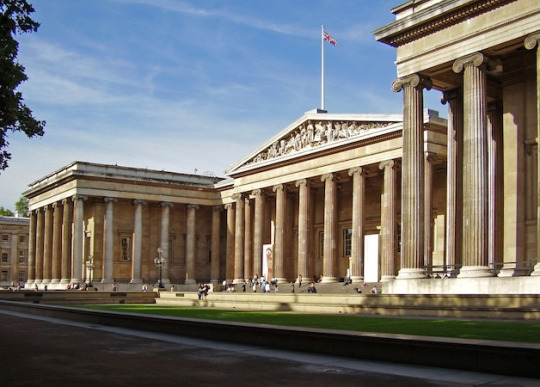
talked to Macaulay,
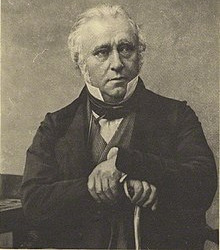
went to Hampton Court,
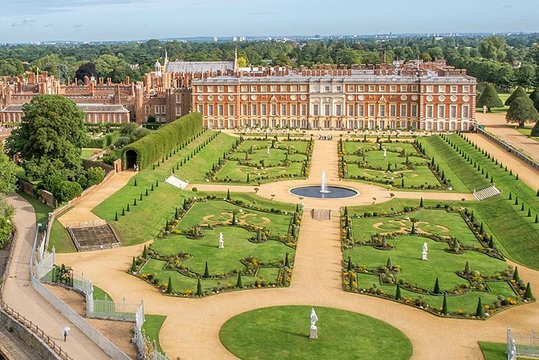
took a picture at photographer Kilburn's studio,

went to the Botanical Gardens,
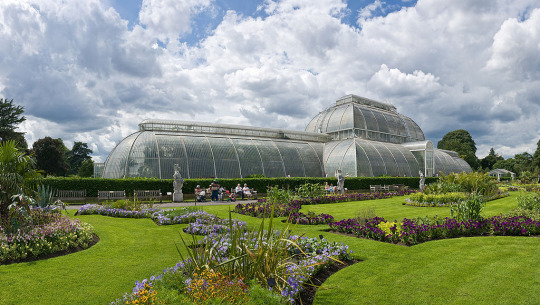
visited the Royal Polytecnical Institution,
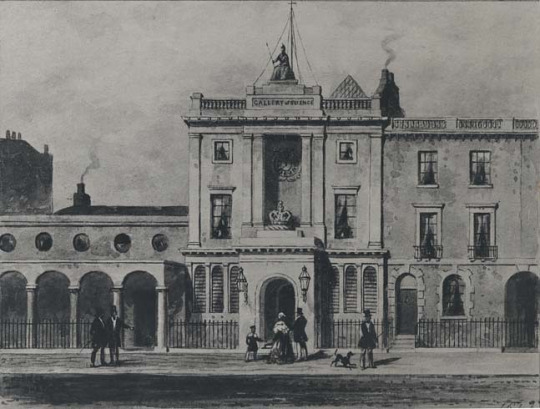
went to Madame Tussaud's Museum,

watched Ascot's races

and, alongside Prince Albert, reviewed the Windsor Horse Guards regiment.
One of the most interesting aspects of his writing resides in the absence of any romantic trace: it is not the Gothic churches, nor the ruined palaces, nor the sunset over the river that fascinate him, but technology. See what he writes about the capital's port: “London's docks are the most beautiful establishment of its kind in Europe and deserves censorship from any traveler who values himself as an observer who does not run to see this wonder of opulence and English judgment." He noted, with astonishment, that those had been done in three years and, even better, without help from the government: “In how many years would it be done in Lisbon, I will not say a similar work, but at least the fourth part? How much government aid would you not need? How much expense would you not bring with you?” In the end, he highlighted, as a cause of English prosperity, the abundance of private credit to finance such ventures.
He also appreciated the streets of the popular neighborhoods, with shops where you could find everything the world produced, "from the greatest futility to the most interesting things, whether economic, scientific or artistic." In the end, he couldn't resist comparing the center of the city, so varied, rich and populous, to the streets of Baixa Lisboeta,
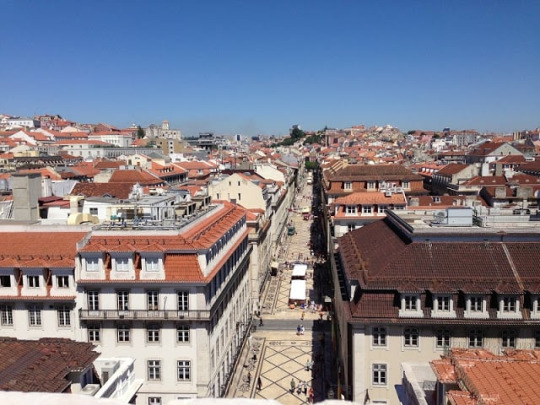
devoid of everything that civilization had to offer. D. Pedro, however, drew attention to the fragility of such opulence - “England is a vast house of commerce; its fall will be a universal bankruptcy.” A fact of Europe should not be foreseen with joy, because "England is the economic box of the whole of Europe." The paragraph ended in a positive way: "Since the laws of fado want a dominant nation to dictate the laws to others, be it England, because it dominates by ingenuity and wealth."
Then, he addressed the question of commercial relations between Portugal and England. After noting that there was an evolution in the taste of the British, in the sense of the preference for “smelling wines” (instead of “taste”), he declared: “Port wines are not manufactured with the care that they should be manufactured, no a distinction is carefully drawn between the different qualities. The diverse qualities of Douro wines are extremely valuable, but unfortunately they are only found in small quantities.” If there was greater freedom of trade, he thought, Portuguese light wines could enter “in happy competition” with French clarets, which would be beneficial for everyone: “Rights, however, hinder the trade of our ordinary red wines which are very preferable French wines, because they combine the aroma of clarets with a taste, and consistency, which they do not have.” Finally, he noted, with astonishment, that São Tomé sugar was on sale in England, and he could not resist adding: “How much wealth is not in its raw state in our colonies!”
The following day, he went to Eton,

noting that the school was attended by 900 young men "from the most illustrious families" and underlining that, in England, "the nobility is educated." After weaving praises for education, he praised Magna Carta, which, contrary to the constitutions of the continent, seemed excellent to him. In the middle of the trip between London and Windsor, he noted: “What advantages would our poor country not take from a railroad!? How much would he not fertilize and enrich the trade in Alentejo, what source of prosperity would he not be for the country?” Questioning, with apprehension, about the intrigues that had been waged in Portugal against the new means of transport: “But when will it be done? Certainly not when petty passions make you sordidly resistant, certainly not until you undertake this work of maximum public utility and respectable names.”
6 notes
·
View notes
Photo

My FIFTEEN SIXTEEN Forces for Change @duchessofostergotlands
I found this incredibly hard. Initially, I tried to keep it to “British” citizens and then I realised that would exclude Malala and she was the very first person on my list so I gave up on that. There were also two people who NEARLY made the list and they were on and off it more than I could count: JK Rowling and Phoebe Waller-Bridge. JK Rowling is a force for change and changed reading and literacy irrevocably. If she hadn’t defended Depp and if she hadn’t made that Twitter account, she probably would be on this list because I think the impact she has had on children reading is so understated. Phoebe Waller-Bridge was my number 17. She is changing the TV landscape and, quite rightly, is the driving force behind 20 of the Emmy nominations this year (Fleabag and Killing Eve). If she was 10% less posh, I think she would have made it.
1. The Silence Breakers: They were TIME 100 Person of the Year in 2017 and it was well-deserved. The Silence Breakers broke the wall of silence around the abuse suffered at the hands of people in power. It changed how people viewed Hollywood and opened the door for lawsuits and criminal charges to be brought against some of the world’s most powerful men.
2. Helen Taylor Thompson: A Special Operations Executive from the age of 19 in World War Two, HTT saved Mildray Hospital from closure in 1952 and turned it into the world’s first AIDs hospice. She also co-founded the Community Action Network.
3. Andria Zafirakou: Andria won the 2018 Global Teachers Prize, the first British person to do so. She is an Arts and Textiles teacher and Deputy Head of her school. She organises extra lessons in her own time (evenings and weekends) when children could come in and work if they were unable to at home. She runs classes on well-being and yoga for the children and ensures she teaches about art from the cultures of her pupils.
4. Together for Yes: The Together for Yes campaign successfully campaigned for abortion to be legalised in the Republic of Ireland. Ireland had some of the worst abortion laws in the world and women who came to England to have life-saving surgery while pregnant would be arrested on their return. Now, those women can legally have abortions outside of life-saving reasons.
5. Katie Piper: Katie survived an acid attack organised by her ex-boyfriend. She founded the Katie Piper Foundation, which raises awareness of the victims of burns and other disfigurement injuries, as well as campaigns for the treatment Katie received to be widely available in the UK. She has also created a lucrative TV career for herself, helping people accept their scars.
6. Doreen Lawrence: Doreen is the mother of Stephen Lawrence, who was murdered in 1993. She regularly campaigns for justice for the victims of racist attacks, as well as for reforms of the police and prison services. She founded the Stephen Lawrence Charitable Trust and was one of the seven specially chosen flagbearers at the 2012 Olympics Opening Ceremony. She is a member of the House of Lords and her designated peerage is Clarendon, Jamaica.
7. Susan Solomon: Solomon is a scientist who was the first person to recognise the hole in the Ozone layer and what caused it, something she did in the 80s. Solomon is one of the leading scientific voices in the battle against climate change and regularly contributes to the climate change Assessment Reports.
8. Nimco Ali: Ali is a Somali-born activist, who campaigns against FGM. She co-founded Daughters of Eve (with Leyla Hussein) after undergoing FGM as a child. Ali wrote a book, allowing women to share “shameful” and “secret” stories, and was a contributing author in Feminists Don’t Wear Pink. I don’t necessarily agree with her politically but that’s neither here nor there.
9. Munroe Bergdorf: Bergdorf is a trans model and the founder of night club, Pussy Palace. She is vocal about the issues faced by trans women of colour and campaigns for trans rights. She has suffered a lot of public backlash and has regularly been stripped from roles and jobs, not all of which have been fair. She opened the doors for British trans models.
10. Amika George: Amika George is a tiny baby an 18 year old, who campaigns against period poverty. She contributed to Feminists Don’t Wear Pink and is the reason secondary schools in England receive funding to provide sanitary products free-of-charge. She is currently campaigning for this to also occur in primary schools.
11. Priyanka Joshi: Joshi is one of the most innovative and important women in the British field of science and she is still under 30. Joshi has made some of the most vital breakthroughs in dementia and Alzheimer’s disease. It is extremely likely she will go on to make some of the biggest scientific discoveries in the field in the future.
12. Malala Yousafzai: She needs no introduction. Malala is far braver than I could ever be. Ignoring the whole shot in the head by the Taliban thing, Malala has done so much. She has opened a school in Lebanon for Syrian refugees and campaigns against injustices across the world. She changed the world as a child and is improving it as an adult.
13. Jameela Jamil: I didn’t think I’d have any crossover with Meg’s choices so Jameela surprised me by her inclusion here. As an eating disorder sufferer, a celebrity who continuously speaks out about the dangers of laxatives and air brushing and about the truth of celebrity images is important to me. Also, I Weigh might not have much of an impact on me, but I know the impact it’s had on others.
14. Majorie Wallace: Majorie Wallace is the reason there are mental health support forums. The Support Forum was the first of its kind and was created as part of SANE, the charity founded by Wallace. She initially focused on schizophrenia, before expanding the focus to reducing the impact of mental illnesses, improving treatment and care by increasing knowledge, and influencing policy and public attitudes of all mental illnesses.
15. Rigoberta Menchú: Menchú is an indigenous Guatemalan who began campaigning against human rights violations while still a teenager. She was exiled from the country in 1981 but she still continued to organise resistance within the country. She has a Nobel Peace Prize and still campaigns today.
AND 16. HRH The Duchess of Cambridge: My wildcard choice. A few years ago I didn’t really know about childhood mental health and I had never even heard of postnatal or perinatal mental health. It’s now at the forefront of my work and my career. Her impact in this area - particularly in bringing awareness to these areas to the public - is immense and, significantly, the impact it has had on my life cannot be understated.
#mine#fccchallenge#forces for change challenge#helen taylor thompson#andria zafirakou#katie piper#doreen lawrence#susan solomon#nimco ali#munroe bergdorf#amika george#priyanka joshi#malala yousafzai#Jameela Jamil#majorie wallace#rigoberta menchu#kate
38 notes
·
View notes
Link
1 note
·
View note
Text
The life of Leslie Howard
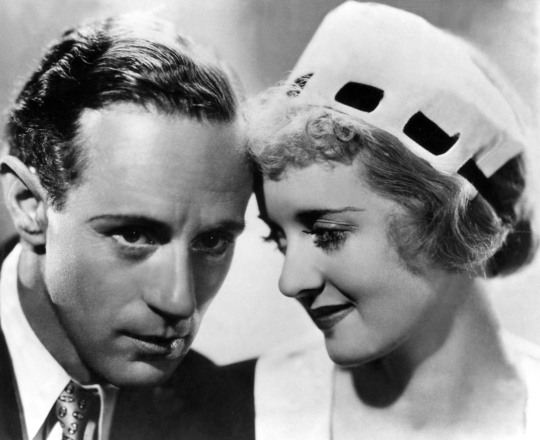
Words Mark Bryant
The actor Leslie Howard, who went to school in Dulwich and who lived in the area for nearly two decades, is probably best known as the gentlemanly Ashley Wilkes in the Hollywood blockbuster Gone with the Wind, which celebrates its 80th anniversary this year.
But he was also a wartime radio broadcaster of British propaganda and the director and star of a number of patriotic wartime films, notably The First of the Few, about the designer of the famous Spitfire fighter plane – which itself has links to Dulwich.
He was born Leslie Howard Steiner at 31 Westbourne Road (now Westbourne Drive), Forest Hill, on April 3 1893, the first child of Hungarian-born stockbroker’s clerk Ferdinand “Frank” Steiner, and his English wife Lilian.
Shortly after his birth the family moved to Vienna, where a sister Dorice and a brother, Alfred, were born. Dorice later founded Hurst Lodge School in Ascot, whose pupils included the actress Juliet Stevenson and the future Duchess of York.
On their return to London, Frank anglicised his surname to Stainer and soon afterwards Leslie and his two siblings were baptised at St Chrysostom’s church in Peckham.
In 1903 another sister, Irene (later a celebrated casting director for MGM and others) was born and, in 1904, Leslie attended Belvedere House preparatory school in Upper Norwood.
The family eventually settled at 45 Farquhar Road by Crystal Palace Park – only a short distance from Dulwich – and lived there from 1907 (when Leslie was 14) to 1910. It was a convenient location as Leslie’s widowed maternal grandmother ran a lodging house at “Woodbury”, 2 Jasper Road, close by.
In September 1907 Leslie was sent to Alleyn’s School. Here he was a near contemporary of the future novelist CS Forester (1899-1996), who was at Alleyn’s around this time.
As his daughter, Leslie Ruth Howard, says in her book A Quite Remarkable Father (1959): “The young Leslie went to school, which he loathed and at which, due to shyness and his afflicting near-sightedness, he was never much good.”
However, he began to write short stories and one-act plays and dreamed of becoming a writer. He later said: “As a boy the possibility of being an actor never even occurred to me... I wanted to write.”
Unfortunately, when he announced that he wanted to be a full-time writer his father had other ideas. Unlike fellow Old Alleynian CS Forester, whose father supported him for six months to get him started, Frank wanted Leslie to get a proper job and took him out of school in April 1910, shortly after his 17th birthday.
As a result, after a brief spell as a junior clerk in the purser’s office of a Thames steamboat company, he commuted daily by train to central London to work as a bank clerk for Cox & Co.
By this time the family had moved to “Allendale”, 4 Jasper Road, next to Leslie’s grandmother. Leslie’s uncle Wilfred Noy, a film director working for the Clarendon Film Company in Croydon, lived next door.
According to Leslie’s daughter, “It was a peaceful neighbourhood of large, ugly red-brick Victorian houses mostly set back from the road, with short carriage drives and pleasant gardens.
“Jasper Road, where the family found themselves, looked over a green valley where trees hid similar houses, and circled a hill on whose summit stood the Crystal Palace.”
Leslie’s mother, who had always been interested in the theatre, set up the Upper Norwood Dramatic Club (UNDC), for which Leslie was honorary secretary as well as playwright, actor and musician. By 1912 the UNDC was appearing regularly at Stanley Halls in South Norwood.
While working at the bank, Leslie continued writing and performing in his spare time with some success. In 1913 his story The Impersonation of Lord Dalton appeared in The Penny Magazine, and his play Deception was reviewed in The Stage. The following year, after the outbreak of World War One, he appeared in a crowd scene in his first film, The Heroine of Mons, directed by his uncle Wilfred.
When he was 21, he volunteered for the army and was commissioned in 1915 as a second lieutenant in a cavalry regiment stationed in Essex. Here he met and married a local girl in the spring of 1916 and was dispatched to France shortly afterwards. However, in May that year he was sent back home suffering from shell-shock.
Deemed unfit for military service, he decided to become a professional actor and changed his name to Leslie Howard. His uncle Wilfred also helped him get a role (his first credited film part) in The Happy Warrior and after acting in various provincial theatres he made his first appearance on the London stage in February 1918.
At about this time his parents and siblings left south-east London and settled in a large house in West Kensington. As a result, Howard, his wife and their young son, Ronald (who was born in Norwood in April 1918), also left and moved in with them.
In the 1920s Leslie went to the USA and began appearing in films, notably Berkeley Square, which earned him an Oscar nomination for best actor. In 1934 he was in an NBC radio play, Without Benefit of Clergy, with another Old Alleynian, Clive Brook, and starred in The Scarlet Pimpernel and Of Human Bondage.
Two years later came The Petrified Forest with his friend Humphrey Bogart (Bogie and Bacall named their daughter Leslie Howard Bogart), followed by Pygmalion in 1938, which earned him another best actor nomination. Leslie’s youngest brother, Arthur also appeared in this film.
Leslie’s last Hollywood film, Gone with the Wind (1939), was ironically greatly admired by Goebbels, and Hitler himself was a fan of Leslie’s co-star Clark Gable, later even offering a reward for his capture and transportation to Germany alive.
With the outbreak of World War Two, Leslie returned to the UK. He joined a Ministry of Information “ideas committee” for propaganda projects and made National Savings films with Noël Coward.
He also bought a house in Surrey and, helped by his friend and neighbour Jonah Barrington, the radio correspondent of the Daily Express, he listened to radio broadcasts from Poland as the Nazis invaded.
By coincidence it was Barrington who coined the nickname “Lord Haw Haw” for the infamous former Dulwich resident William Joyce, who by this time was broadcasting Nazi propaganda to the UK.
By a further coincidence, not only was Leslie later mentioned by name in some of these broadcasts, but the house he lived in when at Alleyn’s School (45 Farquhar Road), was only two doors away from Joyce’s own home (41 Farquhar Road) before he left for Germany in 1939.
Leslie broadcast propaganda himself, notably appearing on the novelist JB Priestley’s popular BBC weekly programme Postscripts, and later alone on Britain Speaks. These talks were broadcast to north America throughout the London Blitz, in an effort to persuade the (then neutral) USA to support the Allies.
In addition, he acted in the Ministry of Information’s first full-length feature film, 49th Parallel and produced, directed and acted in a number of patriotic anti-German propaganda films himself.
These included “Pimpernel” Smith, which was set in Nazi Germany and allegedly inspired Swedish diplomat Raoul Wallenberg to mount his real-life rescue operation in Budapest that saved thousands of Hungarian Jews from Nazi concentration camps. The casting director was Leslie’s sister, Irene, and his son Ronald, by then 23, also appeared in the film.
Another film, regarded by many as his best, was The First of the Few, whose title (suggested by Leslie) refers to a line in Churchill’s famous speech about the RAF’s role in the Battle of Britain: “Never in the field of human conflict was so much owed by so many to so few”. In the film, which has a number of Dulwich links, Leslie plays RJ Mitchell, the designer of the Spitfire fighter plane.
Mitchell’s wife is played by future Dulwich resident Rosamund John (1913-98) who, from 1950, would live in Alleyn Park with her second husband, Old Alleynian politician John Silkin (the third son of Lewis Silkin, 1st Baron Silkin, and a younger brother of another Old Alleynian politician, Samuel Silkin, Baron Silkin of Dulwich).
In addition, one of the real-life test pilots involved with the development of the Spitfire (and on which David Niven’s role as the fictional RAF squadron leader Geoffrey Crisp was partly based), was Old Alleynian wing commander George Hedley Stainforth (1899-1942). Sadly Stainforth was killed on active duty the year the film was released.
Leslie started shooting The First of the Few in the summer of 1941. The following year the Ministry of Information commissioned him to direct a recruitment film, The Gentle Sex, about women serving in the Auxiliary Territorial Service (ATS). Leslie was also the narrator.
Once again future Dulwich resident Rosamund John starred, as one of seven girls from different walks of life who join the ATS. In Leslie’s final film, The Lamp Still Burns, John was cast in the lead role as an architect who becomes a nurse.
In April 1943, shortly after his 50th birthday, Leslie was sent to Lisbon on a British Council lecture tour of neutral Spain and Portugal, which some claimed later was really a top-secret mission for Churchill to dissuade General Franco from joining the Axis powers. Some even thought that he had been mistaken for Churchill himself.
Whatever the truth, when flying back to Bristol from Lisbon, the civilian airliner he was travelling in was shot down on June 1 1943 by Luftwaffe fighters over the Bay of Biscay, and he and all the other people on board were killed.
.......................
Dr Mark Bryant lives in East Dulwich and is the author World War II in Cartoons and other books.
4 notes
·
View notes
Video
youtube
Kingston To Ocho Rios, Jamaica via Highway 2000 / Toll Road (Caribbean). Drive Time: about 1 h 13 min by car or bus from Half Way Tree. Distance: about 88 km. ⭐ Point of interest: 00:11 Carib 5 Cinema 00:13 Cross Roads 00:38 Cross Roads Bus Station 03:31 Flow Jamaica Telephone Company 05:38 Heart Institute of the Caribbean 06:58 Ministry of Transport and Mining 07:02 National Works Agency 07:09 Half Way Tree Police Station 07:13 Half Way Tree Courthouse 07:19 Half Way Tree Fire Station 07:47 Half Way Tree Transport Centre 09:55 Ministry of Justice 10:02 To Usain Bolt's Tracks & Records 10:05 Sandy Gully 10:18 CVM Television Ltd 20:26 Six Miles Overpass 22:46 Highway 2000 Ferry Overpass - On and Off Ramp 23:12 Ferry Police Station 23:35 St Andrew / St Catherine Parish Border 24:33 Highway 2000 East/West - Toll Road 24:54 Highway 2000 Overpass - Clarendon To Kingston 26:22 Highway 2000 North South 26:43 Caymanas Estate Road / Overpass 27:02 Caymanas Park Toll Plaza 28:19 Caymans Estate 29:13 Caymanas Golf Club Road / Overpass 40:59 Mid Island Farm 42:28 Linstead Bypass Road Overpass 42:39 Linstead Exit - Linstead Toll Plaza 44:01 Bauxite Plant (Formally ALCAN) 46:05 Mount Rosser 47:22 St Ann / St Catherine Parish Border 49:56 Faiths Pen Overpass 51:10 Moneague exit | Unity Valley Rest Stop 51:35 Moneague, St Ann 54:40 Overpass near Phoenix Park 56:33 Golden Grove Toll Plaza 01:03:56 Steer Town, St Ann 01:05:51 Roundabout near Drax Hall 01:08:38 Dunn's River Falls & Park 01:09:02 Dolphin Cove Ocho Rios 01:09:44 Mystic Mountain 01:11:58 Reynold's Pier 01:17:02 Ocho Rios Craft Market 01:17:28 Moon Palace Jamaica All Inclusive Resort 01:17:50 Little Pub Plaza 01:18:32 Ocho Rios Town Centre ⭐ Adjoining roads and turn: 00:07 Slipe Road 01:03 Old Hope Road 01:07 Cross Roads Market 01:09 Half Tree Road 01:21 Union Square 01:23 Retirement Road 01:50 Eureka Road 01:56 Retirement Crescent 02:01 Ivy Green Crescent 02:22 Collins Green Avenue 02:43 Beechwood Avenue 03:00 Osbourne Road 03:35 Oxford Road 03:39 To New Kingston 03:42 To Emancipation Park 04:22 Carlton Crescent 04:31 Richmond Avenue 04:33 Carlton Crescent 04:37 Chelsea Avenue 04:49 Grove Road 05:12 Balmoral Avenue 05:27 Skibo Avenue 05:42 Bradley Avenue 05:49 Ballater Avenue 06:08 Maxfield Avenue 06:18 Queens Avenue 06:44 Maxfield Avenue 06:53 Cargill Avenue 07:22 Hagley Park Road 07:25 Eastwood Park Road 07:33 Molynes Road 07:42 South Odeon Avenue 07:55 North Odeon Avenue 08:08 Courtney Walsh Drive 08:16 Hillview Avenue 08:21 Eastwood Avenue 08:29 Westminister Road 08:55 Burlington Avenue 08:55 South Avenue 09:05 Dumbarton Avenue 09:08 Brandon Road 09:25 Red Hills Road 09:28 To Half Way Tree 09:57 West Kings House Road 10:13 Constant Spring Road 10:26 Gore Terrace 10:40 Dunrobin Avenue 10:56 Lindsay Crescent 11:27 Washington Boulevard 11:37 Aldene Drive 11:57 Hugh Miller Avenue 12:20 Hugh Miller Road 13:35 Molynes Road 13:40 To Half Way Tree 13:42 To Zadie Gardens 15:02 Headley Avenue 15:02 Denver Crescent 15:25 Darby Terrace 15:50 Ken Hill Drive 16:28 Patrick Drive 17:29 Weymouth Drive 18:04 Coleyville Avenue 18:29 Duhaney Drive 18:32 Cooreville Community 20:11 To Downtown Kingston 20:38 Mandela Highway 22:02 Tom Cringle Drive 25:11 To Portmore | Caymanas 26:32 To Caymans Estate 32:16 Angels | Spanish Town - Exit 56:33 Golden Grove | Claremont Exit 01:06:03 To Runaway Bay | Montego Bay | Negril 01:06:13 To Ocho Rios | St Mary 01:07:41 Entering Ocho Rios 01:13:26 Ocho Rios Bypass Road 01:13:28 Main Street Ocho Rios 01:13:35 To Ocho Rios Cruise Terminal 01:15:43 Milford Road 01:16:08 Graham Street 01:17:07 Newlin Street 01:18:00 Evelyn Street 01:18:30 James Avenue 01:18:51 Market Street ~~~~~~~~~~~~~~~~~~~~~~~~~~~~~~~~~~~~~~~~~~ 👉 SUBSCRIBE to get updates in Jamaica. https://goo.gl/sDr2yz ~~~~~~~~~~~~~~~~~~~~~~~~~~~~~~~~~~~~~~~~~~ Website: http://bit.ly/2CrIOOr 2019 Road Trip footage using the GoPro HERO4 Silver Edition. MUSIC: "Bomber (Sting)" by Riot (Reggae). #InJamaica #Jamaica #Kingston #OchoRios #Ochi #StAnnJamaica #StAnn by InJamaica
3 notes
·
View notes
Photo

palais typographique
«A treasure, the literary heritage of ancient Rome, had been lost or laid aside; it was for them, the early humanists, to restore the treasure; for their successors, if they were so minded, to invest it, and on the product to build the Palace of Art.» [james wardrop, The Script of Humanism, at the clarendon press, oxford, 1963, pp 3-4]. presumably wardrop alludes to the poem «The Palace of Art» by alfred lord tennyson [written 1832, revised 1842].
this palace upon neo-classical foundation: topology of deformed typographical rule, rendered in tSpace. typeface: linotype didot bold.
0 notes
Text
[read ebook] 5000 Years of Tiles EPUB$

Download Or Read This Ebook at:
http://read.ebookcollection.space/?book=1588343987
Download/Read 5000 Years of Tiles Ebook
information book:
Author : Hans Van Lemmen
Pages : 320
Language :
Release Date :2013-10-22
ISBN :1588343987
Publisher :Smithsonian Books
BOOK DESCRIPTION:
A comprehensive, full-color exploration of tile art and production worldwide, from earliest times to the present day. The book is both an authoritative work of reference and a visual delight, ranging from ancient Greece, where the first fired roof tiles date from as early as the third millennium BC, to twentieth-century Mexico. Along the way we encounter stunning examples of the tiler's art: the enormous English medieval floor pavements from Byland Abbey and Clarendon Palace; figural tiles from China, intended to adorn roofs and ward off evil; the famous Iznik tiles from the Islamic world, with their richly decorative patterns; the highly stylised ceramic tiles of the Arts and Crafts movement; and the tiles created by some of the finest ceramic artists and potters of the twenty-first century.Placing the tiles firmly in their historical and cultural context, the book highlights both continuity and diversity, the dissemination of techniques and designs, and how tile art in one time and place has inspired and rejuvenated those in others. Tiles are also studied in terms of function as well as form, and the full range of architectural and practical purposes for which they have been used - from floors to roofs, stoves to bathrooms, cathedrals to metro stations - will be explored, along with the various techniques employed to create such versatile pieces. 5000 Years of Tiles is the essential, most comprehensive single volume for anyone interested in the ceramic, decorative, and architectural arts.
5000 Years of Tiles pdf download
5000 Years of Tiles audiobook download
5000 Years of Tiles read online
5000 Years of Tiles epub
5000 Years of Tiles pdf full ebook
5000 Years of Tiles amazon
5000 Years of Tiles audiobook
5000 Years of Tiles pdf online
5000 Years of Tiles download book online
5000 Years of Tiles mobile
5000 Years of Tiles pdf free download
download ebook PDF EPUB, book in english language, Download pdf kindle audiobook
0 notes
Text
Alternative Theogonies 4: The Theogony of Pherecydes of Syros
Chapter 4: The Theogony of Pherecydes of Syros (c. Mid 6th Century BC)
Pherecydes of Syros D5 as cited in Diogenes Laertes 1.119: [. . .] the book [. . .] its beginning is: Zas [i.e. Zeus] and Chronos were always, and Chthonie was. But the name of Chthonie became Earth when Zas gave her the earth as a present. {From Early Greek Philosophy, Volume II, Beginners and Early Ionian Thinkers, Part I, p. 173}.
Pherecydes of Syros D6 as cited in Eudemus fragment 117 as cited in Damascius On The Principles 124b: Pherecydes of Syros [scil. says] [. . .] that Chronos made out of his own seed fire, breath, and water [. . .] out of which, when they had been distributed in five nooks, was created another numerous generation of gods, called “the five-nook” one [. . .]. {From Early Greek Philosophy, Volume II, Beginners and Early Ionian Thinkers, Part I, pp. 173, 175}.
Pherecydes of Syros D8 as cited in Proclus Commentary on Plato’s Timaeus 3 ad 32c: [. . .] Pherecydes of Syros said that when Zeus was about to begin his work of creation, he transformed himself into Eros [. . .]. {From Early Greek Philosophy, Volume II, Beginners and Early Ionian Thinkers, Part I, p. 175}.
Pherecydes of Syros D9 as cited in Grenfell Papyrus 2.11 Schibli: [Col. 1] . . . for him [i.e. Zas] they make buildings, many and great; and when they had finished them all, the objects, male servants, female servants, and everything else that is necessary, when then everything is ready, they perform the wedding. And when the third day of the wedding comes, then Zas makes a robe, great and beautiful, and on it he embroiders Earth, Ogenos [i.e. Ocean], and the houses of Ogenos . . . [Col. 2] [Zeus speaks to Chthoniê:] . . . “since I want this marriage to be yours, it is you that I honor with this. But you, receive my greeting and be my wife.” They say that these were the first anakalypteria that were performed, and from this time this custom has existed, for both gods and men. And she answers him, receiving the robe from him . . . {From Early Greek Philosophy, Volume II, Beginners and Early Ionian Thinkers, Part I, pp. 175, 177}.
Pherecydes of Syros D10 as cited in Isidorus F76 as cited in Clement of Alexandria, Stromata 6.53.5: [. . .] the winged oak and the embroidered robe on it [. . .]. {From Early Greek Philosophy, Volume II, Beginners and Early Ionian Thinkers, Part I, p. 177}.
Pherecydes of Syros D11 as cited in Grenfell Papyrus 2.11 Schibli: Pherecydes, who is much more ancient than Heraclitus, invented the myth of one army set in order against another army, gave the command of the one to Cronus and of the other to Ophioneus, and recounted their challenges and combats, and that they made an accord according to which whichever ones of them fell into Ogenos would be defeated, while those who expelled them and defeated them would possess the heavens. {From Early Greek Philosophy, Volume II, Beginners and Early Ionian Thinkers, Part I, p. 177}.
Pherecydes of Syros D12 as cited in Tertullian On The Soldier’s Garland 7.4: Pherecydes reports that Saturn [i.e. Cronus, Khronos] was crowned before everyone [. . .]. {From Early Greek Philosophy, Volume II, Beginners and Early Ionian Thinkers, Part I, p. 177}.
Pherecydes of Syros D13 as cited in Celcus F83 as cited in Origen Against Celsus 6.42: Below that portion is the portion of Tartarus. The daughters of Boreas, the Harpies and Thyella [i.e. Storm], guard it. It is to there that Zeus banishes any of the gods when he commits an outrage. {From Early Greek Philosophy, Volume II, Beginners and Early Ionian Thinkers, Part I, p. 179}.
Pherecydes of Syros D3 as cited in Maximus of Tyre Philosophical Orations 4.4.5: Consider also the poetry of the man from Syros: Zeus, Chthoniê, Eros who is among them, the birth of Ophioneus, the battle of the gods, the tree, and the robe. {From Early Greek Philosophy, Volume II, Beginners and Early Ionian Thinkers, Part I, pp. 171, 173}.
A reconstruction of Pherekydes of Syros’ Cosmogony by Hermann S. Schibli: CHRONOS and Zas always were, and also Chthonie. Once Chronos, alone and without a partner, cast forth his seed. From his seed he made fire, air, and water, and deposited these in five hollows. Lo, from the mixtures of fire, air and water in the hollows arose another generation of gods. The fiery gods dwelt in Ouranos and gleaming Aither, the gods of wind in gusty Tartaros, the watery gods in Chaos, and the gods of darkness dwelt in black Night.
After the generation of gods, born of the seed of Time, assumed their habitations, Zas became Eros and married Chthonie. The other gods built many large palaces for him; they provided all the necessary goods, the banquet tables, servants and maids, and when all the needful things had been accomplished, they performed the wedding. On the third day of the wedding, Zas fashioned a big and beautiful robe, and on it he embroidered Earth and Ogenos and the mansions of Ogenos [and the earth and sea came to be] 1 . When he had finished his task, he presented the robe to Chthonie and said: 'Because I wish to marry you, I honour you with this robe, [which is the earth] 1 . Rejoice and be my consort!' This they say was the first feast of unveiling, and hence arose the custom for both gods and men. And she responded as she received the robe from him: 'I take this as my honour, and henceforth I shall be called Ge...' The gods celebrated, feasting on ambrosia. And the Earth was like a winged oak, strong and mighty; its roots extended into the depths of Tartaros, its trunk was encircled by Ogenos, and its branches reached into Ouranos. The Earth flourished and Zas rejoiced.
But below the Earth, in a hollow of Tartaros, Ophioneus was born. He and his monstrous sons challenged Kronos. [Ophion and Eurynome, daughter of Ocean, governed the world from snow-clad Olympus] 2 . The battle-lines were drawn up, with Kronos the commander of one army and Ophioneus leading the Ophionidai. The terms of the battle were stated: whichever of them fell into Ogenos would be the defeated, while those who thrust them out and defeated them would possess Ouranos. A fierce conflict followed. Kronos had a strong ally in Zas; in single combat he overthrew Ophioneus. [Rhea, skilled in wrestling, likewise cast the former queen Eurynome down into the waters of Ocean.] 23 So Ophioneus and his brood were cast into Ogenos, and they dwell in the mansions of Ogenos to this day. Kronos, commander of the victorious army, was crowned by the other gods (from this arose the custom of the wearing of crowns by victors). Zeus honoured the victorious gods and assigned them their domains. Kronos had won Ouranos. These are the shares of the other gods: below Ouranos is the fiery Aither; below Aither the portion of Earth; below that portion is Tartaros; the daughters of Boreas, the Harpies and Thuella, guard it; there Zeus banishes any of the gods who behave with insolence. There also are the souls of men who have committed bloodshed. Their souls are borne through the portals and gates of Tartaros on an outflowing river to birth; the river is like the seed that leads to new life. And the souls of men depart from life and enter again the caves and hollows of Tartaros through its portals and gates. Alongside Tartaros is Chaos and the realms of dark Night. {From Pherekydes of Syros, written by Hermann S. Schibli, published by Oxford: Clarendon Press, 1990, pp. 128-129}.
Sources
1 Early Greek Myth by Timothy Gantz, published by John Hopkins University Press, 1996, pp. 739-740.
2 Apollonius of Rhodes The Voyage of Argo 1.503-6, translated by E. V. Rieu, published by Penguin Classics, 1971, p. 49.
3 Lycophron Alexandra 1191, translated by A.W. Mair and G.W. Mair, published by Harvard University Press, 1921. Retrieved from https://www.theoi.com/Text/LycophronAlexandra3.html.
0 notes
Text
Why was cinema so popular in the inter-war years?
In inter-war years cinema became an incredibly popular leisure activity especially with working classes and women. It was a cheap leisure activity that was available to all. The films themselves were “only part of the total experience”, especially in the 1920s when purpose built cinemas were emerging as places of splendour exuding luxury. People admired the actors and actresses on screen especially Gracie Fields who is most famous for the film ‘Sing as We Go’. The controversy within the popularity of cinema comes down to the censorship of this medium - it was the most censored within this period. Censorship implies that messages within films were being controlled therefore restricting what people see however, there is evidence that this wasn't the case.
Class and gender played an important role in the increasing popularity of cinema. The cheap films were “consumed as necessity among poorest members” of societies especially working classes as they had the freedom to “take advantage of new opportunities” like the cinema. This meant that for “no more than a few coppers” people no matter what background could “purchase ready-made dreams”. The cinema was “indisputably the most popular form of entertainment”. 1930s cinema was popular among the unemployed too, surveys across the nation showed that the cinema was the “most important leisure activity” for the unemployed. The cinema gave the unemployed an escape to a ‘wish-fulfilment’ world away from the hum-drum lives they lead. Under unemployed married women made up a large proportion and Rowntree found also made up “75% of adult cinema goers”. Women could fit in the cinema around their domestic duties and early on in the inter-war years it was a time for socialising as well as a leisure pursuit. Younger married couples were also more likely to attend the cinema as a pastime compared to older married couples, because the younger generation had the funds necessary as well as more free time due to a reduction in the working week. However cinema was just as important to those in employment, mainly being the young generations who grabbed hold of this “inexpensive form of entertainment” which was also suitable for courting. Some police force members were often heard commenting on how the “cinema performed valuable functions like keeping working class youths off the streets”. Annual admission rates show just how popular in the inter-war years cinema was: from “903 million in 1934” to “1,027 million in 1940” with a weekly average in 1939 of “23 million”. The cinema “gradually acquired a substantial middle class audience” after the cinemas outshone music halls that were originally the source of leisure for the middle classes. These middle classes, “their tastes are almost exactly opposite” to working classes as they attended the cinema for the “film first and foremost” where as to the working classes it was more of a “regular habit”. Middle classes found much of the films and stars to be aimed at the working classes so found some of themes not as engaging. Overall audiences were mainly drawn from “the working class, women, and the young”, these were the inter war cinema enthusiasts that encouraged the vastly popular source of entertainment.
The films themselves were vital to the increased popularity of cinema - they were an exciting and mind-broadening leisure pursuit available to all. The 1920s saw the creation of purpose built cinemas with names such as The Palace and Empress creating an “atmosphere of luxury”. The buildings had marble staircases, fountains, uniformed staff and ushers, and even some cafes. They were built to become part of the fantasy and to allow people to “enter a palace of dreams” and further the film experience.
American films were preferred due to the better quality within the film and more action involved in storylines compared to British films that had too much dialogue and were often poorly made. American films were “opening up a new world” for audiences, as the Daily Express wrote in an edition in 1927 cinema-goers became “‘temporary US citizens’”. Left-wing politicians also described Hollywood films like they were the “‘opiate’ for the masses”. This ‘opiate’ provided the ritualistic element of the films - queueing to enter the places for dreams, sitting in silence and seeing a world of glamour, almost similar to the habit of churchgoing. The cinema can be compared to a cathedral how people flock to it and knew the shape of the building, the seats can be the pews where people sit and listen, and the stars represent the deities that were worshipped within stories. These American films were also allegedly undermining respect for British institutions such as family and marriage as well as “glamourising crime” within “‘gangster’ films”.Within British films there were big names that rose to fame during the inter-war period such as Gracie Fields, Alfred Hitchcock and Charlie Chaplin. Hitchcock became known as the master of suspense, Chaplin was the key in most comedy films and Gracie was known as ‘Our Gracie’. The genres that were most popular were “melodrama, comedy, musicals, and drama” especially some of the thrillers released by Hitchcock.
Sound and colour were also being introduced during the inter-war period with The Jazz Singer being the first feature length ‘talkie’ in 1927 and The Wizard of Oz merging black and white scenes with the technicolour of Oz in 1939. Cinema was making huge strides and this contributed to the popularity as it intrigued audiences. These new advances strengthened the “escapist fantasies” the audience craved. However these inter-war films were criticised for little realistic depiction. To address these criticisms John Grierson introduced the documentary film movement operating within Empire Marketing Board with more emphasis on ordinary, real life themes such as Night Mail (1936) that depicted the operation of a Royal Mail train service experimenting with sound, visuals and narration. This piece portrayed a theme of modernity juxtaposed with tradition and put forward the reliance Britain had developed on the postal system. This type of film would have been shown as an opening act or in schools; however tensions developed within audiences over the educational standpoint and their desire for escapism within the films.
The films were also being censored during the inter-war years more than any other medium at this time. The Censorship Act of 1927 introduced the films that people nicknamed “quota quickies”. This act established a quota for British films to meet so to boost the industry against the strong competition of Hollywood, but it had mixed results. American films were less censored as it was assumed that the public would not translate any social messages through the film, suggesting people were lost in the glamour rather than understanding the messages within. Love on the Dole was a film rejected by the BBFC in 1936 due to the bad language and fights with police - it was eventually filmed in 1940 when the historical setting was more acceptable for the controversial themes. According to Orwell these censored movies “averted revolution” in Britain by controlling the messages that were put through in film. Fielding writes about this controversy between the control or reflection of values in British society. Within his journal piece Fielding argues that cinema “cannot overturn fundamental beliefs and values” but also states later on that the films “shaped popular perceptions”. Here the controversy is clearly a difficult subject; even a historian can’t fully give a true answer. The argument that the films were reflecting views that many of the audience agreed with and created a form of “social control” is evident. Film did not, as some higher classes thought, “‘dope’ the working classes”. These empowering films would include the film ‘Sing as We Go’ that starred the widely loved actress Gracie Fields. This film promoted no class conflict and meeting unemployment with optimism. Higher classes used films as a tool to make profits and distract working classes yet the film’s workers gave genuine optimism and represented Britishness. Films were seen to be encouraging social myths and furthering moral values within classes such as optimism, no class conflicts and sustaining themselves. Films were reflecting themes that the audiences wanted because they kept coming back for more, clearly the themes that were being represented were popular. Popularity continued to rise over the years due to the public’s enjoyment and fascination with the films.
Cinema was growing increasingly popular in the interwar years due to being a cheap pastime which was available to all. It was especially popular with women and youths over this period, mainly because of the themes of the films and characters such as the nation’s favourite Gracie Fields. The films were only a small part of what people loved about the cinema - the surrounding atmosphere and buildings which were built full of grandeur and to imply luxury. US films were more positively received compared to British films because the public grew a want for glamour, thrills and a better quality. Overall cinema was a past-time that all could afford and gave something new to the public that was exciting and widely received through all ages.
Bibliography
Davies, Andrew, ‘Cinema and Broadcasting’, in 20th Century Britain, Economic, Social and Cultural change ed. by Paul Johnson (Longman, London, 1994)
Fielding, Steven, ‘British politics and cinema’s historical dramas, 1929-1938’, The Historical Journal, 56,2 (2013)
Higson, Andrew, Waving the Flag: constructing a national cinema in Britain (Clarendon Press, Oxford, 1995)
McKibbin, Ross, Classes and Cultures England 1918-1951 (Oxford University Press Inc., New York, 1998)
Richards, Jeffery, Age of the Dream Palace Cinema and Society in 1930s Britain (I.B.Tauris & Co Ltd, London, 2009)
Richards, Jeffery, Films and British national identity: from Dickens to Dad’s army, (Manchester University Press, New York, 1997)
Richards, Jeffery, ‘The British Board of Film Censors and content control in the 1930s: images of Britain’, Historical Journal of Film, 1,2 (1981)
Sedgwick, John, ‘Cinema-going Preferences in Britain in the 1930s’, in The Unknown 1930s, an alternative history of the British cinema 1929-1939 ed. by Jeffrey Richards (I.B.Tauris & Co Ldt., London, 2000)
Sedgwick, John, Popular filmgoing in 1930s Britain: a choice of pleasures, (University of Exeter Press, Exeter, 2000)
http://www.screenonline.org.uk/film/id/451833/
0 notes